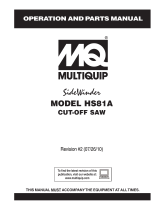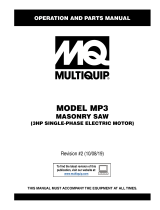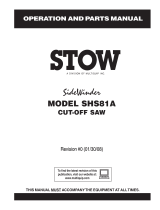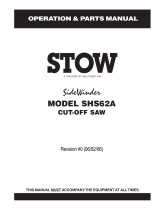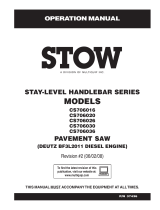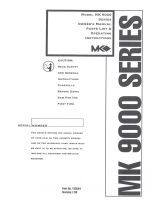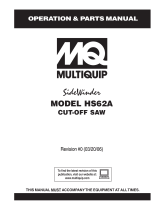Page is loading ...

To find the latest revision of this publication or
associated parts manual, visit our website at:
www.multiquip.com
OPERATION MANUAL
THIS MANUAL MUST ACCOMPANY THE EQUIPMENT AT ALL TIMES.
Revision #3 (09/25/19)
PN: 38206
StreetPro SERIES
MODEL SP118
PROFESSIONAL PAVEMENT SAW
(HONDA GX390U1QWT2 GASOLINE ENGINE)

PAGE 2 — SP118 PAVEMENT SAW • OPERATION MANUAL — REV. #3 (09/25/19)
PROPOSITION 65 WARNING

SP118 PAVEMENT SAW • OPERATION MANUAL — REV. #3 (09/25/19) — PAGE 3
Grinding/cutting/drilling of masonry, concrete, metal and
other materials with silica in their composition may give
off dust or mists containing crystalline silica. Silica is a
basic component of sand, quartz, brick clay, granite and
numerous other minerals and rocks. Repeated and/or
substantial inhalation of airborne crystalline silica can
cause serious or fatal respiratory diseases, including
silicosis.In addition, California and some other
authorities have listed respirable crystalline silica as a
substance known to cause cancer. When cutting such
materials, always follow the respiratory precautions
mentioned above.
WARNING
Grinding/cutting/drilling of masonry, concrete, metal and
other materials can generate dust, mists and fumes
containing chemicals known to cause serious or fatal
injury or illness, such as respiratory disease, cancer,
birth defects or other reproductive harm. If you are
unfamiliar with the risks associated with the particular
process and/or material being cut or the composition of
the tool being used, review the material safety data
sheet and/or consult your employer, the material
manufacturer/supplier, governmental agencies such as
OSHA and NIOSH and other sources on hazardous
materials. California and some other authorities, for
instance, have published lists of substances known to
cause cancer, reproductive toxicity,or other harmful
effects.
Control dust, mist and fumes at the source where
possible. In this regard use good work practices and
follow the recommendations of the manufacturers or
suppliers, OSHA/NIOSH, and occupational and trade
associations.Water should be used for dust
suppression when wet cutting is feasible. When the
hazards from inhalation of dust, mists and fumes cannot
be eliminated, the operator and any bystanders should
always wear a respirator approved by NIOSH/MSHA for
the materials being used.
WARNING
SILICOSIS WARNING RESPIRATORY HAZARDS
SILICOSIS/RESPIRATORY WARNINGS

PAGE 4 — SP118 PAVEMENT SAW • OPERATION MANUAL — REV. #3 (09/25/19)
TABLE OF CONTENTS
SP118 StreetPro
Professional Pavement Saw
Proposition 65 Warning ........................................... 2
Silicosis/Respiratory Warnings ................................ 3
Table Of Contents .................................................... 4
Training Checklist .................................................... 6
Daily Pre-Operation Checklist ................................. 7
Safety Information .............................................. 8-14
Dimensions ............................................................ 16
Specifications (Saw) .............................................. 16
Specifications (Engine) .......................................... 17
General Information ............................................... 18
Components .......................................................... 19
Basic Engine .......................................................... 20
Inspection/Setup ............................................... 21-23
Blades ............................................................... 24-26
Raise/Lower And Depth Stop ................................ 27
Operation .......................................................... 28-31
Maintenance (Saw) ................................................ 32
Maintenance (Engine) ........................................... 33
Decommissioning/Water Tank (Optional)............... 34
Troubleshooting (Saw) ........................................... 35
Troubleshooting (Engine) ....................................... 36

SP118 PAVEMENT SAW • OPERATION MANUAL — REV. #3 (09/25/19) — PAGE 5
NOTES

PAGE 6 — SP118 PAVEMENT SAW • OPERATION MANUAL — REV. #3 (09/25/19)
TRAINING CHECKLIST
Training Checklist
No, Description OK? Date
1
Read operation manual
completely.
2
Machine layout, location of
components, checking of engine
and hydraulic oil levels.
3 Fuel system, refueling procedure.
4 Operation of spray and lights.
5
Operation of controls (machine
not running).
6
Safety controls, safety stop switch
operation.
7 Emergency stop procedures.
8
Startup of machine, pre-heat,
engine choke.
9 Forward and reverse travel.
10 Starting a cut.
11 Pavement cutting techniques.
12 Stopping a cut.
13
Restart after stopping blade within
work surface — explanation
14 Shutdown of machine.
15 Lifting of machine (lift loops).
16 Machine transport and storage.

SP118 PAVEMENT SAW • OPERATION MANUAL — REV. #3 (09/25/19) — PAGE 7
DAILY PRE-OPERATION CHECKLIST
Daily Pre-Operation Checklist
1 Hardware and damage check
2 Engine oil level
3 Hydraulic oil level
4 Condition of blade
5 Safety stop switch operation
6 Braking control operation

PAGE 8 — SP118 PAVEMENT SAW • OPERATION MANUAL — REV. #3 (09/25/19)
SAFETY INFORMATION
Do not operate or service the equipment before reading
the entire manual. Safety precautions should be followed
at all times when operating this equipment.
Failure to read and understand the safety
messages and operating instructions could
result in injury to yourself and others.
SAFETY MESSAGES
The four safety messages shown below will inform you
about potential hazards that could injure you or others. The
safety messages specifi cally address the level of exposure
to the operator and are preceded by one of four words:
DANGER, WARNING, CAUTION
or NOTICE.
SAFETY SYMBOLS
DANGER
Indicates a hazardous situation which, if not avoided,
WILL result in DEATH or SERIOUS INJURY.
WARNING
Indicates a hazardous situation which, if not avoided,
COULD result in DEATH or SERIOUS INJURY.
CAUTION
Indicates a hazardous situation which, if not avoided,
COULD result in MINOR or MODERATE INJURY.
NOTICE
Addresses practices not related to personal injury.
Potential hazards associated with the operation of this
equipment will be referenced with hazard symbols which
may appear throughout this manual in conjunction with
safety messages.
Lethal exhaust gas hazards
Explosive fuel hazards
Burn hazards
Rotating parts hazards
Symbol Safety Hazard
Cutting and crushing hazards
Hydraulic fluid hazards

SP118 PAVEMENT SAW • OPERATION MANUAL — REV. #3 (09/25/19) — PAGE 9
SAFETY INFORMATION
GENERAL SAFETY
WARNING
Adherence to the OSHA 2017 Ruling governing
Occupational Exposure to Respirable Crystalline Silica,
requires that all sawing operations MUST BE conducted
with an integrated water delivery system that feeds water
to the blade.
CAUTION
NEVER operate this equipment without proper protective
clothing, shatterproof glasses, respiratory protection,
hearing protection, steel-toed boots and other protective
devices required by the job or city and state regulations.
Avoid wearing jewelry or loose fi tting clothes that may
snag on the controls or moving parts as this can cause
serious injury.
NEVER operate this equipment when not
feeling well due to fatigue, illness or when
under medication.
NEVER operate this equipment under the
infl uence of drugs or alcohol.
ALWAYS clear the work area of any debris, tools, etc.
that would constitute a hazard while the equipment is
in operation.
No one other than the operator is to be in the working
area when the equipment is in operation.
DO NOT
use the equipment for any purpose other than
its intended purposes or applications.
NOTICE
This equipment should only be operated by trained and
qualifi ed personnel 18 years of age and older.
Whenever necessary, replace nameplate, operation and
safety decals when they become diffi cult read.
Manufacturer does not assume responsibility for any
accident due to equipment modifi cations. Unauthorized
equipment modifi cation will void all warranties.
NEVER
use accessories or attachments that are not
recommended by Multiquip for this equipment. Damage
to the equipment and/or injury to user may result.
ALWAYS know the location of the nearest
fi re extinguisher.
ALWAYS know the location of the nearest
fi rst aid kit.
ALWAYS know the location of the nearest phone or
keep
a phone on the job site.
Also, know the phone numbers
of the nearest ambulance, doctor and
fi re department.
This information will be invaluable in the case of an
emergency.

PAGE 10 — SP118 PAVEMENT SAW • OPERATION MANUAL — REV. #3 (09/25/19)
SAFETY INFORMATION
SAW SAFETY
DANGER
Engine fuel exhaust gases contain poisonous carbon
monoxide. This gas is colorless and odorless, and can
cause death if inhaled.
The engine of this equipment requires an adequate free
fl ow of cooling air. NEVER operate this equipment in any
enclosed or narrow area
where free fl ow of the air is
restricted. If the air fl ow is
restricted it will cause injury
to people and property and
serious damage to the
equipment or engine.
NEVER operate the equipment in an explosive
atmosphere or near combustible materials. An
explosion or fi re could result causing severe
bodily harm or even death.
WARNING
If applicable, NEVER use your hand to fi nd
hydraulic leaks. Use a piece of wood or
cardboard. Hydraulic fl uid injected into the
skin must be treated by a knowledgeable
physician immediately or severe injury or
death can occur.
Accidental starting can cause severe injury
or death. ALWAYS place the ON/OFF
switch in the OFF position.
NEVER disconnect any emergency or safety devices.
These devices are intended for operator safety.
Disconnection of these devices can cause severe injury,
bodily harm or even death. Disconnection of any of these
devices will void all warranties.
CAUTION
Anytime the saw is lifted onto its nose or tilted fully
back, such as for maintenance access, the high end of
the saw MUST be blocked up to prevent the possibility
of crush injury.
DANGEROUS
GAS FUMES
NOTICE
ALWAYS ensure saw is securely
placed on appropriate
blocks or jackstands when performing maintenance
requires elevation of the saw.
If saw has brakes, ensure brakes are applied when
leaving or when using on a slope. Some saws utilize a
brake system where the brakes are automatically applied
when the engine is stopped.
If saw has a parking brake, ensure that the parking
brake is engaged and holds the saw safely in place
when parking on a slope.. Turning the saw across the
angle of the slope will help prevent accidental downhill
movement.
ALWAYS
block the saw with appropriate blocks when
leaving the saw parked on a slope.
To prevent unexpected loss of control, DO NOT
start
engine on a sloping surface
DO NOT
use on excessive slopes or on extremely uneven
surfaces
ALWAYS keep the machine in proper running condition.
Fix damage to machine and replace any broken parts
immediately.
Make sure there is no buildup of concrete, grease, oil or
debris on the machine.
ALWAYS
store equipment properly when it is not being
used. Equipment should be stored in a clean, dry location
out of the reach of children and unauthorized personnel.

SP118 PAVEMENT SAW • OPERATION MANUAL — REV. #3 (09/25/19) — PAGE 11
SAFETY INFORMATION
BLADE SAFETY
WARNING
Rotating blade can cut and crush. ALWAYS
keep hands and feet clear while operating
the saw.
CAUTION
NEVER operate the saw without blade
guards and covers in place. Exposure of
the diamond blade must not exceed 180
degrees.
Verify the engine start switch is set to the OFF position
before installing a blade.
ALWAYS inspect blade before each
use. The blade should exhibit no cracks,
dings, or fl aws in the steel centered core
and/or rim. Center (arbor) hole must be
undamaged and true.
NOTICE
Use proper blades and follow blade manufacturer’s
recommendations. Match the blade RPM (blade shaft
RPM) to the recommended blade surface feet per minute
(SFPM).
Ensure the 5/8" blade-mounting bolt is tightened to 125-
175 foot lbs. of torque.
ALWAYS examine blade flanges for damage and
excessive wear.
Ensure the blade is marked with an operating speed
greater than the spindle speed of the saw.
Only cut the material that is specifi ed for the diamond
blade. Read the specifi cation of the diamond blade to
ensure the proper tool has been matched to the material
being cut.
Ensure that water is used during sawing operations and
that a suffi cient fl ow of water is applied to both sides of
the blade.
DO NOT drop the diamond blade on ground or surface.
Ensure that the blade is mounted for proper operating
direction.
Adhere to the blade manufacturer’s recommendations
on handling, storage and safe usage of blades.
ENGINE SAFETY
WARNING
DO NOT place hands or fingers inside
engine compartment when engine is
running.
NEVER
operate the engine with heat shields or
guards removed.
Keep fi ngers, hands hair and clothing away
from all moving parts to prevent injury.
ALWAYS shut down the engine before
performing service or maintenance.
DO NOT
remove the engine oil drain plug while the
engine is hot. Hot oil will gush out of the oil tank and
severely scald any persons in the general area of the
saw.
CAUTION
NEVER touch the hot exhaust manifold,
muffl er or cylinder. Allow these parts to cool
before servicing equipment.
Make certain the operator knows how to and is capable
of turning the engine OFF in case of an emergency.
NOTICE
NEVER
run engine without an air fi lter or with a dirty air
fi lter. Severe engine damage may occur. Service air fi lter
frequently to prevent engine malfunction.
NEVER tamper with the factory settings
of the engine or engine governor. Damage
to the engine or equipment can result
if operating in speed ranges above the
maximum allowable.

PAGE 12 — SP118 PAVEMENT SAW • OPERATION MANUAL — REV. #3 (09/25/19)
SAFETY INFORMATION
FUEL SAFETY
DANGER
DO NOT add fuel to equipment if it is placed inside truck
bed with plastic liner. Possibility exists of explosion or
fi re due to static electricity
DO NOT start the engine near spilled fuel or combustible
fl uids. Fuel is extremely fl ammable and its vapors can
cause an explosion if ignited.
ALWAYS refuel in a well-ventilated area, away from
sparks and open fl ames.
ALWAYS use extreme caution when working with
fl ammable liquids.
DO NOT fi ll the fuel tank while the engine is running
or hot.
DO NOT overfi ll tank, since spilled fuel could ignite if it
comes into contact with hot engine parts or sparks from
the ignition system.
Store fuel in appropriate containers, in well-ventilated
areas and away from sparks and fl ames.
NEVER use fuel as a cleaning agent.
DO NOT smoke around or near the
equipment. Fire or explosion could result
from fuel vapors or if fuel is spilled on a
hot engine.
FUEL
FUEL
BATTERY SAFETY (ELECTRIC START ONLY)
DANGER
DO NOT
drop the battery. There is a possibility that the
battery will explode.
DO NOT expose the battery to open fl ames,
sparks, cigarettes, etc. The battery contains
combustible gases and liquids. If these
gases and liquids come into contact with a
fl ame or spark, an explosion could occur.
WARNING
ALWAYS wear safety glasses when
handling the battery to avoid eye irritation.
The battery contains acids that can cause
injury to the eyes and skin.
Use well-insulated gloves when picking up
the battery.
ALWAYS
keep the battery charged. If the battery is not
charged, combustible gas will build up.
DO NOT
charge battery if frozen. Battery can explode.
When frozen, warm the battery to at least 61°F (16°C).
ALWAYS
recharge the battery in a well-ventilated
environment to avoid the risk of a dangerous concentration
of combustible gases.
If the battery liquid (dilute sulfuric acid)
comes into contact with clothing or skin,
rinse skin or clothing immediately with
plenty of water.
If the battery liquid (dilute sulfuric acid) comes into
contact with eyes
, rinse eyes immediately with plenty
of water and contact the nearest doctor or hospital to
seek medical attention.
CAUTION
ALWAYS disconnect the
NEGATIVE battery terminal
before performing service on the equipment.
ALWAYS
keep battery cables in good working condition.
Repair or replace all worn cables.

SP118 PAVEMENT SAW • OPERATION MANUAL — REV. #3 (09/25/19) — PAGE 13
SAFETY INFORMATION
LIFTING SAFETY
CAUTION
NEVER allow any person or animal to stand underneath
the equipment while lifting.
Some saws are very heavy and awkward to move around.
Use proper heavy lifting procedures.
DO NOT attempt to lift the saw by the guards, handle
bars or front pointers.
NOTICE
The easiest way to lift the saw is to utilize the lifting bale. A
strap or chain can be attached to the lifting bale, allowing
a forklift or crane to lift the saw up onto and off of a slab
of concrete. The strap or chain should have a minimum
of 2,000 pounds (1,000 kg) lifting capacity and the lifting
gear must be capable of lifting at least this amount.
Before lifting, make sure that the lifting bale is not
damaged.
Use one point suspension hook and lift straight upwards.
LIFTING BALE
NEVER tip the engine to extreme angles during lifting as
it may cause oil to gravitate into the cylinder head, making
the engine start diffi cult.
Always make sure crane or lifting device has been
properly secured to the lifting bale.
DO NOT lift machine to unnecessary heights.
NEVER lift the equipment while the engine is running.
ALWAYS
use ramps capable of supporting the weight of
the saw and the operator to load and unload the saw.
TRANSPORTING SAFETY
NOTICE
ALWAYS shutdown engine before transporting.
Tighten fuel tank cap securely and close fuel cock to
prevent fuel from spilling.
ALWAYS
tie down equipment during transport by
securing the equipment with rope.
Ensure that the diamond blade does not come into contact
with the ground or surface during transportation.
NEVER
transport the saw to or from the job site with the
blade mounted.

PAGE 14 — SP118 PAVEMENT SAW • OPERATION MANUAL — REV. #3 (09/25/19)
SAFETY INFORMATION
ENVIRONMENTAL SAFETY/DECOMMISSIONING
NOTICE
Decommissioning is a controlled process used to safely
retire a piece of equipment that is no longer serviceable.
If the equipment poses an unacceptable and unrepairable
safety risk due to wear or damage or is no longer cost
effective to maintain (beyond life-cycle reliability) and is to
be decommissioned (demolition and dismantlement),be
sure to follow rules below.
DO NOT pour waste or oil directly onto the ground, down
a drain or into any water source.
Contact your country's Department of
Public Works or recycling agency in your
area and arrange for proper disposal of
any electrical components, waste or oil
associated with this equipment.
When the life cycle of this equipment is over, remove
battery and bring to appropriate facility for lead
reclamation. Use safety precautions when handling
batteries that contain sulfuric acid.
When the life cycle of this equipment is over, it is
recommended that the trowel frame and all other metal
parts be sent to a recycling center.
Metal recycling involves the collection of metal from
discarded products and its transformation into raw
materials to use in manufacturing a new product.
Recyclers and manufacturers alike promote the process
of recycling metal. Using a metal recycling center
promotes energy cost savings.
EMISSIONS INFORMATION
NOTICE
The gasoline engine used in this equipment has been
designed to reduce harmful levels of carbon monoxide
(CO), hydrocarbons (HC) and nitrogen oxides (NOx)
contained in gasoline exhaust emissions.
This engine has been certifi ed to meet US EPA Evaporative
emissions requirements in the installed confi guration.
Attempting to modify or make adjustments to the engine
emmission system by unauthorized personnel without
proper training could damage the equipment or create an
unsafe condition.
Additionally, modifying the fuel system may adversely affect
evaporative emissions, resulting in fi nes or other penalties.
Emission Control Label
The emission control label is an integral part of the emission
system and is strictly controlled by regulation(s).
The label must remain with the engine for its entire life.
If a replacement emission label is needed, please contact
your authorized Honda Engine Distributor.
SILICA INFORMATION
WARNING
Adherence to the OSHA 2017 Ruling governing
Occupational Exposure to Respirable Crystalline Silica,
requires that all sawing operations MUST BE
conducted
with an integrated water delivery system that feeds water
to the blade.

SP118 PAVEMENT SAW • OPERATION MANUAL — REV. #3 (09/25/19) — PAGE 15
NOTES

PAGE 16 — SP118 PAVEMENT SAW • OPERATION MANUAL — REV. #3 (09/25/19)
DIMENSIONS/SPECIFICATIONS
Figure 1. SP118 Dimensions
Table 1. Dimensions
REFERENCE LETTER DESCRIPTION DIMENSION
A Height w/handle– in. (cm) 43.00 (109 cm)
B Length w/pointer raised – in. (cm) 46.0" (117 cm)
C Length w/pointer lowered – in. (cm) 67.0" (170 cm)
D Height w/o handle– in. (cm) 37.0" (94 cm)
E Width – in. (cm) 25.0" (64 cm)
F Rear Wheel Base – in. (cm) 17.0" (40 cm)
G Front Wheel Base – in. (cm) 10.0" (25.4 cm)
H Handle Bar Width – in. (cm) 24.5" (40 cm)
Table 2. Saw Specifications
Model SP118
Maximum Spindle RPM 2836 RPM
Arbor Size 1.0" (2.54 cm)
Maximum Cutting Depth in. (cm) 7.0" (17.78 cm)
Maximum Operating Mass 274 lbs. (124.3)
Nominal Mass (without blade or fluids) 259 lbs. (117.5)
C
B
A
D
E
F
G
H

SP118 PAVEMENT SAW • OPERATION MANUAL — REV. #3 (09/25/19) — PAGE 17
SPECIFICATIONS
NOTES:
1. Sound Pressure and Power Levels are “A” weighted Measures per ISO 226:2003 (ANSI S1.4-1981). They are measured with the operating
condition of the machine which generates the most repeatable but highest values of the sound levels. Under normal circumstances, the sound
level will vary depending on the condition of the material being worked upon.
2. The vibration level indicated is the vector sum of the RMS (Root Mean Square) Values of amplitudes on each axis, standardized to an 8 hour
exposure period, and obtained using operating condition of the machine that generates the most repeatable but highest values in accordance
with the applicable standards for the machine.
3. Per EU Directive 2002/44/EC, the daily exposure action value for hand-arm vibration is 2.5 m/s
2
∑A(8). The daily exposure limit value is
5 m/s
2
∑A(8).
Table 3. Noise and Vibration Emissions
Guaranteed ISO 11201:2010 Based
Sound Pressure Level at Operator Station in dB(A)
93
Guaranteed ISO 3744:2010 Based
Sound Power Level in dB(A)
107
Hand-Arm Vibration Per ISO 5349-1:200
in m/s
2
∑A(8)
2.27
Table 4. Engine Specifications
Engine
Model HONDA GX390U1QWT2
Type
Air-cooled 4 stroke, Single cylinder, OHV,
Gasoline Engine
Bore x Stroke
3.5 in. x 2.5 in.
(88 mm x 64 mm)
Displacement 23.7 cu-in. (389 cc)
Net HP Output
11.7 HP (8.7 kW) @3600 rpm
Fuel Tank Capacity
Approx. 1.72 U.S. Gallons
(6.5 Liters)
Fuel
Unleaded Automobile Gasoline
86 Octane or higher
Lube Oil Capacity 1.16 U.S. qt. (1.1 liter)
Speed Control Method
3.1 in. (78 mm)
Engine Oil Capacity
Centrifugal Fly-weight Type
Dry Net Weight 68.3 lbs. (31.0 Kg)
Dimensions (L x W x H)
16.7 in. x 17.7 in. x 17.4 in
(425 mm x 450 mm x 443 mm).

PAGE 18 — SP118 PAVEMENT SAW • OPERATION MANUAL — REV. #3 (09/25/19)
GENERAL INFORMATION
INTENDED USE
Operate the SP118 Saw, tools and components in
accordance with the manufacturer's instructions. Use of
any other tools for stated operation is considered contrary
to designated use. The risk of such use lies entirely with the
user. The manufacturer cannot be held liable for damages
as a result of misuse.
GENERAL INFORMATION
The MQ SP118 Saw is designed for wet cutting of concrete
or asphalt utilizing Diamond Blades. These saws have
been engineered for general and industrial flat sawing
applications.The reinforced steel box frame design adds
strength necessary to reduce blade vibrations while cutting.
By minimizing blade vibrations the performance of the blade
is enhanced and thus the life of the blade is extended.
Heavy-duty front and rear axles, sturdy oversized wheels,
and industrial undercarriage assembly ensure accurate
tracking and years of reliable use.
Additionally, the general strength-to-weight ratio design
of the frame and chassis assembly provides for optimum
weight distribution to keep the blade running true in the cut.
A rugged spindle bearing assembly ensures minimal flutter
and shaft harmonics providing the most advantageous
condition for a diamond blade at operating speeds.
This saw comes equipped with an 18-inch blade guard and
handles Diamond Blades ranging in size from 12-18-inches
in diameter.
Figure 2. SP118 Saw
POWER PLANTS
The SP118 saw is generally considered a "low" powered
saw in the industry. This classification is particularly useful
when selecting the proper diamond blade for an application.
This SP118 saw is powered by a HONDA GX390U1QWT2
air cooled, 4-stroke, single cylnder, OHV gasoline engine
rated at 11.7 HP (8.7 kW) at 3,600 RPM.
Refer to the HONDA Engine Owner's Manual for specific
information regarding engine operation and maintenance
procedures.
BLADE ROTATION
Three premium 3VX belts connecting a properly sized drive
(engine) pulley and an output blade shaft pulley provides
the rotational power of the diamond blade. Specific pulley
diameters have been chosen to support the design of the
SP118 saw.
Ultimate blade shaft RPM speed is very important for the
safe, efficient operation of the diamond blade in the cut.
All SP118 SAWS are designed, engineered and
manufactured with strict adherence to American
National Standards Institute, Inc. (ANSI) guidelines
B7.1 and B7.5.
FEATURES
Powerful HONDA GX390 Gasoline engine with cyclone
air filtration.
Adjustable Anti-Vibration Handle Bar.
Easy adjusting Raise/Lower System with Positive Depth
Lock.
Infinite adjusting Depth Feed Gauge.
Over-center Lifting Bale.
Left OR Right side sawing.
Hinged front Blade Guard.
Rugged Pointer Tracking Arm.
Super-rigid steel box frame.
Manual Wheel Brake.
Water delivery system for Left/Right hand sawing.

SP118 PAVEMENT SAW • OPERATION MANUAL — REV. #3 (09/25/19) — PAGE 19
COMPONENTS
For quick reference, Figure 3 highlights basic features of
the SP118 Saw.
1. Engine Stop Switch — Located on the handle bar,
easy toggle to STOP engine.
2. Anti-Vibration Handle Bar — Assists in the harmonic
damping of the saw. Adjustable in height and collapses
flush against the saw frame for efficient storage.
3. Water Connector — Standard garden hose connector
station to deliver cooling water to the blade.
4. Wrench (1.5" Box-end) — Use when removing the
Blade Shaft Nut.
5. Latch — Raise/Lower mechanical STOP.
6. Raise/Lower Hand Wheel —
Clockwise
to raise
blade out of cut —
Counter-clockwise
to lower blade
into cut .
7. Parking Brake — Mechanical clamping stop.
8. Wheels — Heavy-duty roller wheel bearings with
grease fitting.
9. Flange Cover — Guard required for protection as the
flange rotates during operations.
10. Blade Guard — Covers saw blade and flips up to allow
blade changes. Must be kept in place during sawing
operations.
11. Front Pointer — Adjustable device to allow accurate
blade tracking during sawing operations.
12. Engine — HONDA GX390 Gasoline Engine with
Cyclone air filtration and oil alert systems.
13. Lifting Bale — Over-center lifting point for safe
transportation of saw.
7
2
3
4
1
5
6
11
12
13
10
8
9
Figure 3. Components

PAGE 20 — SP118 PAVEMENT SAW • OPERATION MANUAL — REV. #3 (09/25/19)
BASIC ENGINE
Figure 4. Engine Components
The engine (Figure 4) must be checked for proper
lubrication and filled with fuel prior to operation. Refer to
the manufacturers engine manual for instructions & details
of operation and servicing.
1. Fuel Filler Cap — Remove this cap to add unleaded
gasoline to the fuel tank. Make sure cap is tightened
securely. DO NOT over fill.
2. Throttle Lever — Used to adjust engine RPM speed
(lever advanced forward SLOW, lever back toward
operator FAST).
3. Engine ON/OFF Switch —ON position permits engine
starting, OFF position stops engine operations.
4. Recoil Starter (pull rope) — Manual-starting method.
Pull the starter grip until resistance is felt, then pull
briskly and smoothly.
DANGER
Adding fuel to the tank should be done
only when the engine is stopped and has
had an opportunity to cool down. In the
event of a fuel spill, DO NOT attempt to
start the engine until the fuel residue has
been completely wiped up, and the area surrounding
the engine is dry.
5. Fuel Valve Lever — OPEN to let fuel flow, CLOSE to
stop the flow of fuel.
6. Choke Lever — Used in the starting of a cold engine,
or in cold weather conditions. The choke enriches the
fuel mixture.
7. Air Cleaner — Prevents dirt and other debris from
entering the fuel system. Remove wing-nut on top of
air filter cannister to gain access to filter element.
8. Spark Plug — Provides spark to the ignition system.
Clean spark plug once a month.
9. Muffler — Used to reduce noise and emissions.
10. Fuel Tank — Holds unleaded gasoline. For additional
information refer to engine owner's manual.
NOTICE
Operating the engine without an air filter, with a
damaged air filter, or a filter in need of replacement
will allow dirt to enter the engine, causing rapid engine
wear.
WARNING
Engine components can generate extreme heat. To
prevent burns, DO NOT touch these areas while the
engine is running or immediately after operating. NEVER
operate the engine with the muffler removed.
/
